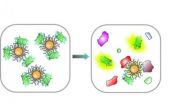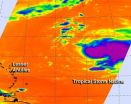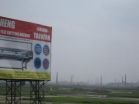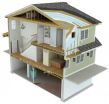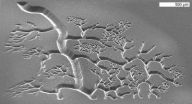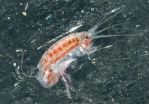(Press-News.org) AMHERST, Mass. – In the fight against cancer, knowing the enemy's exact identity is crucial for diagnosis and treatment, especially in metastatic cancers, those that spread between organs and tissues. Now chemists led by Vincent Rotello at the University of Massachusetts Amherst have developed a rapid, sensitive way to detect microscopic levels of many different metastatic cell types in living tissue. Findings appear in the current issue of the journal ACS Nano.
In a pre-clinical non-small-cell lung cancer metastasis model in mice developed by Frank Jirik and colleagues at the University of Calgary, Rotello's team at UMass Amherst use a sensor array system of gold nanoparticles and proteins to "smell" different cancer types in much the same way our noses identify and remember different odors. The new work builds on Rotello and colleagues' earlier development of a "chemical nose" array of nanoparticles and polymers able to differentiate between normal cells and cancerous ones.
Rotello explains, "With this tool, we can now actually detect and identify metastasized tumor cells in living animal tissue rapidly and effectively using the 'nose' strategy. We were the first group to use this approach in cells, which is relatively straightforward. Now we've done it in tissues and organs, which are very much more complex. With this advance, we're much closer to the promise of a general diagnostic test."
Until now the standard method for precisely identifying cancer cells used a biological receptor approach, a protein binding to a cancer cell wall. Its major drawback is that one must know the appropriate receptor beforehand. Rotello and colleagues' breakthrough is to use an array of gold nanoparticle sensors plus green fluorescent protein (GFP) that activates in response to patterns in the proteins found in cancer cells within minutes, assigning a unique signature to each cancer.
The chemist says, "Smell 'A' generates a pattern in the nose, a unique set of activated receptors, and these are different for every smell we encounter. Smell 'B' has a different pattern. Your brain will instantly recognize each, even if the only time you ever smelled it was 40 years ago. In the same way, we can tune or teach our nanoparticle array to recognize many healthy tissues, so it can immediately recognize something that's even a little bit 'off,' that is, very subtly different from normal. It's like a 'check engine' light, and assigns a different pattern to each 'wrong' tissue. The sensitivity is exquisite, and very powerful."
For this work, the researchers took healthy tissue and mouse tumor samples and trained the nanoparticle-GFP sensor array to recognize them and the GFP to fluoresce in the presence of metastatic tissue. Metastases are differentiated from healthy tissue in a matter of minutes, providing a rapid and very general means of detecting and identifying cancer and potentially other diseases using minimally invasive microbiopsies.
"It's sensitive to really subtle differences," says Rotello. "Even though two cheeses may look the same, our noses can tell a nicely ripe one from a cheese that's a few days past tasting good. In the same way, once we train the sensor array we can identify whether a tissue sample is healthy or not and what kind of cancer it is with very high accuracy. The sensitivity is impressive from a sample of only about 2,000 cells, a microbiopsy that's less invasive for patients."
In addition to the high sensitivity, the authors point out, their sensor is able to differentiate between low (parental) and high (bone, adrenal, and ovary) metastases, as well as between site-specific cells such as breast, liver, lung and prostate cancers.
"Overall, this array-based sensing strategy presents the prospect of unbiased phenotype screening of tissue states arising from genetic variations and differentiation state." Their next step will be to test the new sensor array method in human tissue samples, the researchers say.
INFORMATION:
UMass Amherst chemists develop nose-like sensor array to 'smell' cancer diagnoses
Chemists have developed a rapid, sensitive way to detect microscopic levels of many different metastatic cell types in living tissue; Findings appear in the current issue of the journal ACS Nano
2012-09-14
ELSE PRESS RELEASES FROM THIS DATE:
'Smart growth' strategies curb car use, greenhouse gas emissions, SF State study suggests
2012-09-14
A new study finds that smart growth approaches to urban planning could substantially reduce the number of miles that residents drive in a year. The research was published this week in The B.E. Journal of Economic Analysis and Policy.
Smart growth focuses on the development of compact, walkable cities with houses and jobs located close together. By shortening residents' commutes, this form of urban design aims to cut transportation-related energy use and greenhouse gas emissions. California is already pursuing smart growth in order to meet emissions reductions set by the ...
NASA sees wind shear battering Tropical Storm Nadine
2012-09-14
Tropical Storm Nadine is struggling against wind shear and some dry air. Infrared satellite imagery from NASA showed that Nadine's most powerful thunderstorms were being pushed east of the center.
NASA's Aqua satellite passed over Tropical Storm Nadine early on Sept. 13 and saw several factors that indicated the storm was still struggling to achieve hurricane status.
Infrared data from the Atmospheric Infrared Sounder (AIRS) that flies aboard Aqua found the strongest thunderstorms with very cold cloud temperatures (colder than -63F/-52C) were being pushed east of Nadine's ...
Warmer temperatures make new USDA plant zone map obsolete
2012-09-14
Gardeners and landscapers may want to rethink their fall tree plantings. Warming temperatures have already made the U.S. Department of Agriculture's new cold-weather planting guidelines obsolete, according to Dr. Nir Krakauer, assistant professor of civil engineering in The City College of New York's Grove School of Engineering.
Professor Krakauer developed a new method to map cold-weather zones in the United States that takes rapidly rising temperatures into account. Analyzing recent weather data, he overhauled the Department of Agriculture's latest plant zone map released ...
Researchers develop rapid method to measure carbon footprints
2012-09-14
Researchers have developed new software that can rapidly calculate the carbon footprints of thousands of products simultaneously, a process that up to now has been time consuming and expensive. The methodology should help companies to accurately label products, and to design ways to reduce their environmental impacts, said Christoph Meinrenken, the project's leader and associate research scientist at Columbia University's Earth Institute and Columbia Engineering. A new study, published online in the Journal of Industrial Ecology, describes the methodology.
The project ...
Home sweet lab: Computerized house to generate as much energy as it uses
2012-09-14
In a ribbon-cutting ceremony on Sept. 12, 2012, the U.S. Commerce Department's National Institute of Standards and Technology (NIST) unveiled a new laboratory designed to demonstrate that a typical-looking suburban home for a family of four can generate as much energy as it uses in a year. Following an initial year-long experiment, the facility will be used to improve test methods for energy-efficient technologies and develop cost-effective design standards for energy-efficient homes that could reduce overall energy consumption and harmful pollution, and save families money ...
Nanoengineers can print 3D microstructures in mere seconds
2012-09-14
Nanoengineers at the University of California, San Diego have developed a novel technology that can fabricate, in mere seconds, microscale three dimensional (3D) structures out of soft, biocompatible hydrogels. Near term, the technology could lead to better systems for growing and studying cells, including stem cells, in the laboratory. Long-term, the goal is to be able to print biological tissues for regenerative medicine. For example, in the future, doctors may repair the damage caused by heart attack by replacing it with tissue that rolled off of a printer.
Reported ...
Childrem of immigrants come out ahead of peers
2012-09-14
Children of immigrants are outperforming children whose family trees have deeper roots in the United States, learning more in school and then making smoother transitions into adulthood, according to sociologists at The Johns Hopkins University.
Researchers Lingxin Hao and Han S. Woo tracked nearly 11,000 children from as young as age 13 into their early 30s, coming from families with diverse backgrounds. When comparing children with similar socioeconomic status and school conditions, Hao and Woo found that the best students, and later the most successful young adults, ...
Surviving without ice
2012-09-14
With sea ice in the Arctic melting to record lows in summer months, marine animals living there face dramatic changes to their environment. Yet some crustaceans, previously thought to spend their entire lives on the underside of sea ice, were recently discovered to migrate deep underwater and follow ocean currents back to colder areas when ice disappears.
"Our findings provide a basic new understanding of the adaptations and biology of the ice-associated organisms within the Arctic Ocean," said Mark Moline, director of the University of Delaware's School of Marine Science ...
Should I marry him?
2012-09-14
Doubt is not a pleasant mental state, but certainty is a ridiculous one.
—Voltaire
In the first scientific study to test whether doubts about getting married are more likely to lead to an unhappy marriage and divorce, UCLA psychologists report that when women have doubts before their wedding, their misgivings are often a warning sign of trouble if they go ahead with the marriage.
The UCLA study demonstrates that pre-wedding uncertainty, especially among women, predicts higher divorce rates and less marital satisfaction years later.
"People think everybody has ...
Obesity more common among rural residents than urban counterparts, study finds
2012-09-14
KANSAS CITY, Kan.—A new study finds that Americans living in rural areas are more likely to be obese than city dwellers. Published in the National Rural Health Association's Fall 2012 Journal of Rural Health, the study indicates that residential location may play an important role in the obesity epidemic.
Led by researchers at the University of Kansas, the study analyzed data collected by the National Center for Health Statistics and is the first in more than three decades to use measured heights and weights. Previous studies have relied on self-reported data, which typically ...
LAST 30 PRESS RELEASES:
HKUST Engineering researchers developed a novel photodetector to enhance the performance of on-chip light monitoring
Strategic river sensors could have forewarned of Texas Camp flood disaster
Drone sampling of whale breath reveals first evidence of potentially deadly virus in Arctic
Roman soldiers defending Hadrian’s Wall infected by parasites, study finds
Pinochet’s prisoners were tormented with music but still found solace in it, a new book reveals
Fertility remains high in rural Tanzania despite access to family planning
AI-assisted device can improve autism care access
Kinetic careers
Uncovering how parasitic plants avoid attacking themselves to improve crop resistance
Nanoparticle vaccine strategy could protect against Ebola and other deadly filoviruses
Study finds brain care score can predict risk of stroke across racial groups
Key lung immune cells can intensify allergic reactions
Do hormones explain why women experience more gut pain?
New materials conduct ions in solids as easily as in liquids
Breakthrough of the Year: Renewable energy begins to eclipse fossil fuel-based sources
LLM use is reshaping scientific enterprise by increasing output, reducing quality and more
Introducing LightGen, a chip for ultra-fast, ultra-efficient generative AI
Astronomers see fireworks from violent collisions around nearby star
ACC/AHA issue new guideline on managing congenital heart disease in adults
Cosmic crash caught on camera
Is talented youth nurtured the wrong way? New study shows: top performers develop differently than assumed
Ants: An untapped resource in the development of antibiotics?
Archaeologists use AI to create prehistoric video game
Mitochondria migrate toward the cell membrane in response to high glucose levels
Tiny viral switch offers hope against drug-resistant bacteria
Most parents aware of early peanut introduction guidelines, but confused about details
HPV vaccine can protect against severe lesions of the vulva and vagina
Virtual care provision and emergency department use among children and youth
Quadrivalent HPV vaccine and high-grade vulvovaginal lesions
Insights into dry eyes gained from stem cell-derived tear glands
[Press-News.org] UMass Amherst chemists develop nose-like sensor array to 'smell' cancer diagnosesChemists have developed a rapid, sensitive way to detect microscopic levels of many different metastatic cell types in living tissue; Findings appear in the current issue of the journal ACS Nano
